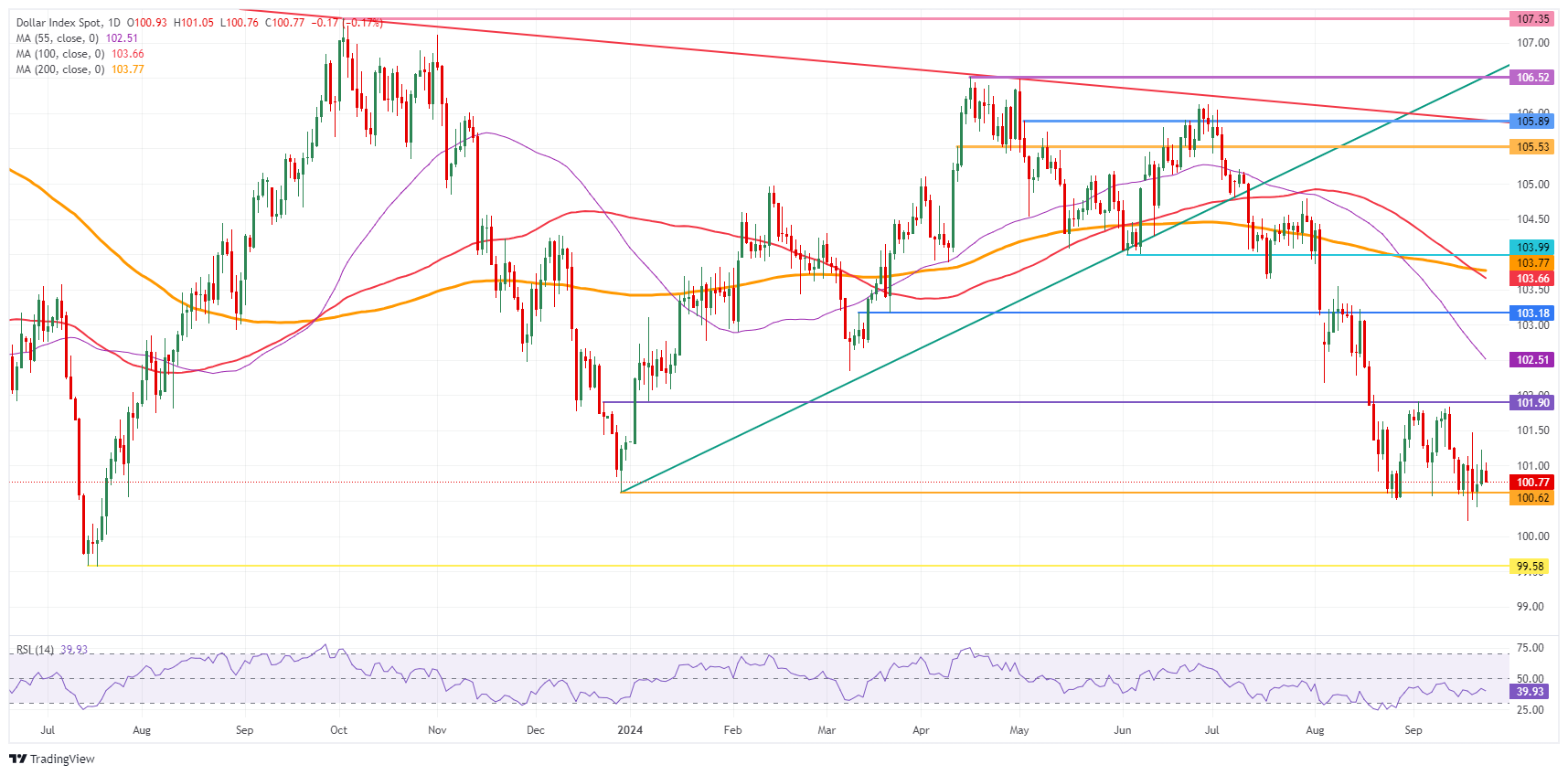- The US dollar is trading calmly on Tuesday after Asian equity markets rose on the back of China’s stimulus plans.
- Equity markets are applauding China’s injection of liquidity totalling 500 billion yuan.
- The Dollar Index remains stuck in the September range, unable to break out in any direction.
The US Dollar (USD) is trading mixed on Tuesday after the Chinese government issued measures to revive its sluggish economy. Key elements of the plan are the 500 billion yuan (CNY) injection and the liquidity line with the People’s Bank of China (PBoC) that allows funds and brokers to get cash to buy stocks. This caused the Chinese Yuan (CNY) to rally nearly 0.50% against the Dollar during Tuesday’s Asian trading session.
On the economic data front, a relatively light calendar ahead with some second-tier data on Tuesday. The Richmond Fed manufacturing index for September could be the most influential on the market, aside from Federal Reserve Governor Michelle Bowman, who is expected to comment on the US economic outlook and monetary policy.
Daily Market Wrap: Richmond Fed Leads Tuesday
- On the geopolitical front, an emergency United Nations meeting has been called for Tuesday for Lebanon following intense bombing over the weekend and Monday by Israel.
- Tuesday will kick off with Federal Reserve Governor Michelle Bowman delivering a speech on the U.S. economic outlook and monetary policy at the Kentucky Bankers Association Annual Convention. Remarks are expected to come around 13:00 GMT.
- At the same time, the housing price index for July is expected to be published. A positive increase of 0.2% is expected after the small contraction of 0.1% in June.
- At 14:00 GMT, the Richmond Fed manufacturing index for September will be released, which is expected to rise slightly to -17 from -19 in August.
- At the same time, the consumer confidence reading is expected to come in at 104.0, up from 103.3 previously.
- Equity markets are having a good day, with China’s Hang Seng and the Shanghai Shenzhen index up more than 4% at the close on Tuesday. European and US stocks are following suit with smaller gains.
- The CME’s Fedwatch tool shows a 48.5% chance of a 25 basis point rate cut at the Fed’s next meeting on November 7, while 51.5% are pricing in another 50 basis point rate cut.
- The US 10-year benchmark rate is trading at 3.79%, flirting with a new September high.
Dollar Index Technical Analysis: DXY in a state of nirvana
The DXY Dollar Index looks a bit stuck, even broken, and again locked in that tight September range near yearly lows. Looking at yields and interest rate differentials between the US and other countries, it doesn’t seem to add up that the US Dollar is where it is right now. Traders are waiting for more data to assess where the Dollar Index should go and commit to a given trend.
The upper level of the September range remains at 101.90. Further up, the index could reach 103.18, with the 55-day simple moving average (SMA) at 102.51 on the way. The next band up is very hazy, with the 100-day SMA at 103.66 and the 200-day SMA at 103.77, just before the large round level of 104.00.
On the downside, 100.62 (the December 28, 2023 low) is the first support, and a break could signal further weakness ahead. If that occurs, the July 14, 2023 low at 99.58 will be the next level to watch. If that level gives way, early 2023 levels are closer to 97.73.
Dollar Index DXY: Daily Chart
The banking crisis FAQs
The March 2023 banking crisis occurred when three US-based banks with heavy exposure to the technology sector and cryptocurrencies suffered a surge in withdrawals that revealed serious weaknesses in their balance sheets, resulting in their insolvency.
The highest-profile bank was California-based Silicon Valley Bank (SVB), which saw a surge in withdrawal requests due to a combination of clients fearing the fallout from the FTX debacle and substantially higher returns being offered elsewhere.
In order to make the repayments, Silicon Valley Bank had to sell its holdings of Treasury bonds, mainly from the US. However, due to the rise in interest rates caused by the Federal Reserve’s rapid tightening measures, Treasury bonds had declined substantially. The news that SVB had suffered a loss of $1.8 billion from the sale of its bonds triggered panic and precipitated a large-scale run on the bank that ended with the Federal Deposit Insurance Corporation (FDIC) having to take it over. The crisis spread to San Francisco-based First Republic, which was eventually rescued by a coordinated effort by a group of large US banks. On March 19, Credit Suisse in Switzerland went bankrupt after several years of poor results and had to be absorbed by USB.
The banking crisis was negative for the US Dollar (USD) because it changed expectations about the future path of interest rates. Before the crisis, investors expected the Federal Reserve (Fed) to continue raising interest rates to combat persistently high inflation; however, once it became clear how much pressure this was putting on the banking sector by devaluing bank holdings of US Treasury bonds, the expectation was that the Fed would pause or even reverse its policy path. Since higher interest rates are positive for the US Dollar, the dollar fell as the possibility of a shift in monetary policy was ruled out.
The banking crisis was a bullish event for the price of Gold. First, it benefited from demand due to its status as a safe haven asset. Second, it led investors to expect the Federal Reserve (Fed) to pause its aggressive rate-hiking policy, fearing the impact on the financial stability of the banking system: expectations of lower interest rates reduced the opportunity cost of holding Gold. Third, Gold, which is priced in US Dollars (XAU/USD), rose in value because the US Dollar weakened.
Source: Fx Street
I am Joshua Winder, a senior-level journalist and editor at World Stock Market. I specialize in covering news related to the stock market and economic trends. With more than 8 years of experience in this field, I have become an expert in financial reporting.








